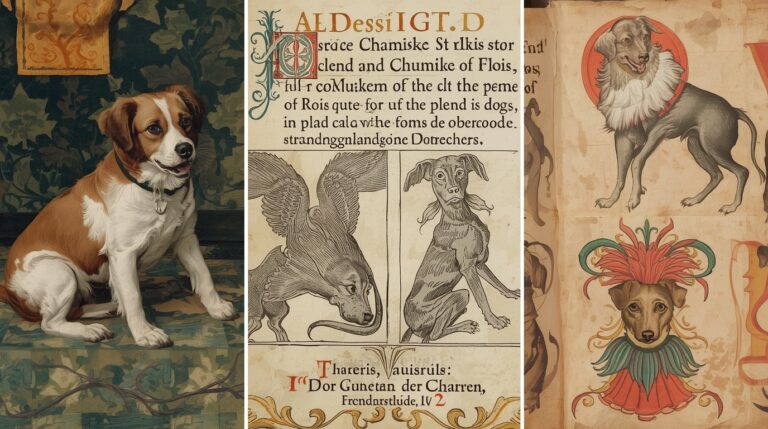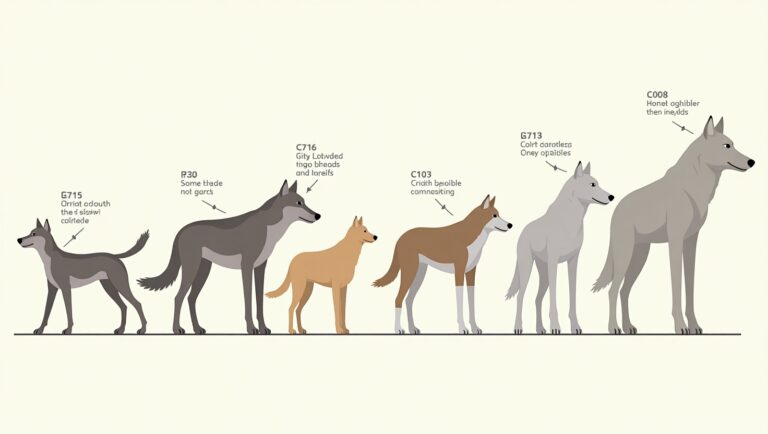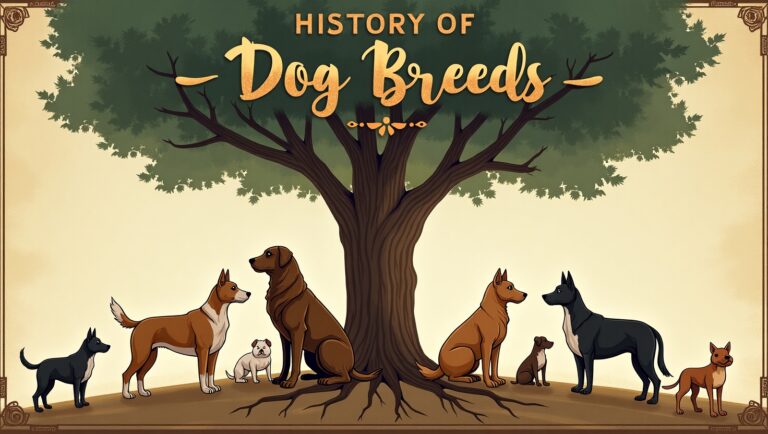Genetic Studies on Dog Ancestry

Introduction: Unraveling Dog Evolution Through Genetics
The story of how dogs became humans’ oldest companions is written in their genes. While archaeological sites and ancient art provide visual evidence of early dog domestication, it is through genetic studies on dog ancestry that scientists have traced the evolutionary divergence from wolves, uncovered the timeline of domestication, and revealed complex interbreeding events across continents. With the advancement of ancient DNA sequencing, mitochondrial haplogroup mapping, and whole-genome analysis, the evolutionary past of Canis lupus familiaris is being reconstructed in stunning detail.
Why Genetic Studies Matter in Canine Ancestry
Before the age of genetics, researchers relied heavily on morphology—bone shape, cranial measurements, and dentition—to distinguish early dogs from wolves. However, the line between wolf and dog was often blurry. Genetic data allows researchers to bypass subjective morphology and instead examine the actual blueprint of evolution. With it, they can:
- Date divergence events
- Map haplogroups and ancestral lineages
- Detect admixture between wolves and dogs
- Understand the effects of selective breeding
The Early Genetic Puzzle: Dog or Wolf?
Initial DNA studies focused on mitochondrial DNA (mtDNA), which is maternally inherited and mutates at a predictable rate. Early comparisons between dog and wolf mtDNA sequences confirmed that dogs descended from a now-extinct population of gray wolves (Canis lupus). However, the question remained: where and when did this divergence occur? Was there a single domestication event, or did it happen multiple times across Eurasia?
Mitochondrial DNA in Early Dog Research
In the 1990s and early 2000s, scientists began analyzing mtDNA from ancient dog remains, particularly from sites like Bonn-Oberkassel, Goyet Cave, and Zhokhov Island. These studies revealed distinct haplogroups (such as A, B, C, and D) in ancient and modern dogs. The presence of similar haplotypes across wide geographic regions suggested early gene flow between canine populations and hinted at multiple domestication or introgression events.
What mtDNA Haplogroups Tell Us About Domestication
Mitochondrial haplogroups act like family trees of maternal lineage. Key findings from mtDNA studies include:
- Haplogroup A: Found worldwide; thought to originate in East Asia
- Haplogroup C: Common in early European dogs
- Haplogroup D: Linked to Arctic and Siberian populations
The dominance of haplogroup A in modern dogs suggests a genetic bottleneck in early domestication, possibly caused by human-driven selective breeding or population collapse in wild canid ancestors.
The Shift to Nuclear and Whole-Genome Analysis
While mtDNA provides a narrow view, nuclear DNA (which combines both maternal and paternal input) offers a full genomic picture. Recent advances in whole-genome sequencing (WGS) have revolutionized the field. By comparing entire genomes of dogs and wolves, researchers can pinpoint:
- Exact divergence times
- Genes affected by domestication
- Signatures of selective sweeps
WGS has also enabled the identification of traits related to behavior, digestion, and cognition—many of which differentiate dogs from wolves.
Divergence from Wolves: What the Genome Reveals
Whole-genome analyses estimate that dogs diverged from wolves between 20,000 and 40,000 years ago. This predates agriculture, indicating that domestication occurred among hunter-gatherer societies. The genomes of modern dogs show approximately 0.2% to 1.5% divergence from wolves, suggesting a close ancestral relationship, but also clear evolutionary separation.
Domestication Bottlenecks and Genetic Drift
One notable genetic feature of early domesticated dogs is the presence of a domestication bottleneck—a sharp reduction in genetic diversity caused by selective breeding or environmental stress. This is evident in:
- Reduced heterozygosity
- Fixed alleles in certain populations
- Loss of rare haplotypes
Such bottlenecks can be seen in modern breed dogs, but evidence shows they were already occurring in early dog populations, possibly due to isolation in human camps or migratory groups.
Genetic Admixture Between Wolves and Early Dogs
Contrary to the notion of clean speciation, genetic studies show that early dogs and wolves interbred. This genetic admixture was confirmed by identifying introgressed genes from wolves into dog genomes, especially in regions associated with sensory perception and behavioral traits. Ancient wolf-dog hybrids may have contributed adaptive genes that helped dogs survive in diverse environments.
Selective Sweeps: Traits Shaped by Human Preference
A selective sweep occurs when a desirable gene rapidly increases in frequency in a population. Several genomic regions in dogs show evidence of selective sweeps in genes related to:
- Amylase production (digesting starch)
- Neurotransmitter receptors (affecting tameness)
- Facial morphology (shortened snouts and expressive faces)
These traits highlight how early humans unintentionally or intentionally selected for dogs that were more sociable, less aggressive, and better adapted to human diets.
Coevolution in Action: Genes Reflecting Social Bonding
Genetic research supports the idea of coevolution—where dogs and humans influenced each other’s evolution. Dogs developed increased sensitivity to human vocal tone, eye gaze, and emotional cues. Some of these capabilities are traced to specific genes, such as:
- OXTR: Oxytocin receptor gene linked to bonding
- MC2R: Stress-response modulation
- FOXP2: Associated with communication in humans and animals
These genes underwent modifications in domesticated dogs that parallel their behavioral integration into early human societies.
Ancient DNA (aDNA) from Fossils and Its Significance
Ancient DNA (aDNA) refers to genetic material extracted from archaeological remains, such as bones and teeth. Advances in next-generation sequencing (NGS) allow scientists to retrieve fragmented DNA from fossils thousands of years old. aDNA gives us:
- Confirmed domestication timelines
- Fossil-to-modern genome comparisons
- Clearer understanding of early dog populations
Samples from Goyet Cave (Belgium) and Bonn-Oberkassel (Germany) have produced aDNA sequences that help map the earliest stages of dog domestication.
Case Study: Goyet Cave Canid and Genetic Links
The Goyet Cave specimen, dated to around 31,700 years ago, sparked debate over whether it was a wolf or early dog. Genetic analysis revealed it as a basal canid lineage, predating modern dogs but distinct from wolves. Although not a direct ancestor, the specimen shows genetic overlap with early domesticated lineages, offering insight into pre-domestication divergence.
Case Study: Bonn-Oberkassel Dog and Domestication Traits
The Bonn-Oberkassel dog, buried alongside humans 14,200 years ago, is one of the oldest confirmed domesticated dogs. Genetic testing found sequences consistent with modern dog haplogroups, and skeletal analysis showed signs of long-term human care during illness. The DNA supported both domestication status and functional integration into human life.
Genome of Zhokhov Island Dogs: Arctic Adaptation
At Zhokhov Island in Siberia, 9,000-year-old dog remains were found in association with sledding and hunting tools. Their genomes revealed genes linked to cold adaptation, enhanced endurance, and social behavior. These dogs were likely selectively bred for their utility in Arctic environments, offering the earliest genetic evidence of functional specialization in canines.
Comparing Prehistoric Canine Populations
With dozens of ancient genomes now sequenced, scientists have begun comparing prehistoric canine populations:
- East Asian lineages show higher genetic diversity
- European dogs exhibit earlier signs of domestication bottlenecks
- Arctic dogs demonstrate early adaptation to harsh climates
These findings suggest regional domestication events that later merged due to human migration and trade.
Eurasian vs. East Asian Origins: What the Genes Say
One major debate in dog ancestry is whether domestication began in East Asia or Eurasia. Early mtDNA studies favored East Asia, while later whole-genome analyses suggest a dual-origin hypothesis:
- East Asia may have been the cradle of initial domestication
- Western Eurasia saw a secondary domestication or replacement event
This complexity reflects parallel domestication events or extensive gene flow between early dog populations.
also read this Origins and Domestication of Dogs
The Role of the Dog10K Project in Modern Understanding
The Dog10K Genomes Project aims to sequence 10,000 dog and wild canid genomes, including:
- Village dogs
- Modern breeds
- Ancient DNA samples
- Wolves, jackals, and coyotes
This massive dataset helps map lineage divergence, detect breed-specific mutations, and identify health markers. It supports global collaboration on understanding domestication, functional genes, and behavioral evolution.
Genetic Traces of Functional Specialization
Genomes of early dogs reflect task-specific adaptations, such as:
- Sled dogs: Muscle and thermoregulation genes
- Hunting dogs: Olfactory and agility-related genes
- Herding dogs: Obedience and cognitive traits
These findings validate archaeological assumptions and confirm that selective breeding has ancient roots.
Dogs and the Human Genome: Cross-species Influences
Interestingly, dog ancestry research has influenced human evolutionary studies. Dogs act as proxies for:
- Tracing ancient human migration
- Detecting settlement patterns
- Reconstructing dietary shifts
By analyzing dog genomes, researchers infer when and where humans settled, traded, or bred animals.
Identifying Ancient Hybridization Events
Genetic research has confirmed hybridization events between:
- Dogs and wolves
- Dogs and coyotes (in the Americas)
- Dogs and jackals (Africa)
These hybrid events introduce novel traits, increase diversity, and complicate lineage purity. They are tracked using admixture mapping and phylogenetic trees.
How Migration Patterns Are Traced Through Canine DNA
Dog genetics help trace ancient human migrations, such as:
- Out-of-Africa routes
- Siberian-Arctic movements
- Pacific Island expansion
- Bering Land Bridge crossings
Because dogs often traveled with humans, their genomes serve as mirrors of human population movement over thousands of years.
Limitations of Genetic Research in Dog Ancestry
While powerful, genetic studies on dog ancestry face challenges:
- aDNA degrades over time
- Sampling bias toward certain regions
- Complexity of admixture events
- Difficulty distinguishing hybrid vs. pure populations
Multidisciplinary integration with archaeology, linguistics, and anthropology helps overcome these limitations.
Future of Genomics in Dog Evolution Studies
The future of canine ancestry research lies in:
- Pan-genome construction
- Machine learning in genomic interpretation
- Linking genes to behavior
- Identifying health risk alleles
- Comparative genomics across species
With each genome sequenced, we move closer to understanding not just where dogs come from, but how they became what they are today.
Conclusion: The Genetic Blueprint of Man’s Oldest Ally
From ancient mitochondrial haplotypes to cutting-edge genome editing, the field of dog ancestry genetics has reshaped our understanding of evolution, domestication, and human history. What began as a partnership around prehistoric campfires has left lasting signatures in the DNA of both species. As science advances, we continue to unravel the genetic blueprint of man’s oldest and most faithful companion.





